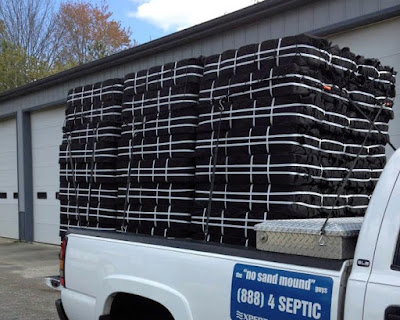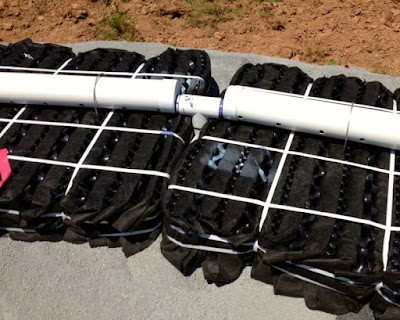Eljen GSF
Basic install pics
if you are installing an Eljen GSF system (in Pennsylvania) for the first time these are the pics we want you to see... we'll be onsite to assist you BUT want you to have some idea of the layout... we may already be talking to you on the phone right now! if not please call us so we can guide you…
a load of modules ready to go... the number of modules depends on absorption bed size... that is determined by perc results
one Eljen GSF module... 3' wide x 4' long
one Eljen GSF module 3' wide x 4' long x 7" thick... about 15lbs
typical bed layout... modules on top of 12 inches (and only 12") of type A concrete sand (ASTM C33) no limestone dust!
laterals are level end to end but they "step down" the slope...
again, the top of the bed is NOT level like the elevated sand mound... the laterals "step down" the slope… only using 12" of sand and the "stepping down" the slope can take far less room than the elevated sand mound.. on this site a sand mound would have run over the property line
modules layout... the distance between the modules is based on perc rate and should be spelled out on the design… again, notice the "step down" of the laterals… this is a 15% slope site and an elevated sand mound wouldn't fit on this property...
(BTW in about 10-12 more pics you are going to see this bed after final cover and then again with grass on it...)
ok, the pipe in the pipe thing... yes it looks weird on the design... BUT easy to do in the field...
pressure line lays out just as you are used to doing EXCEPT the holes face up... then you are sliding the 4" (schedule 35 or better) over the pressure line... holes in the 4" are at 5:00 & 7:00 o'clock position... there will be a few additional holes at the 6:00... we stock small quantities of 3 hole SDR 4"
does your design show a traditional end feed?
these next few pictures show END FEED
its easier and you only have clean outs on one end
call and we can discuss switching from center to end
end feed on slope
pipe in a pipe not that difficult... half way thru the first lateral you'll have figured out how to do it faster
drill hole in 4" end cap slide it over the pressure pipe
this site is a traditional center feed
remember you are just "sleeveing" the 4" SDR 35 over the pressure line... the 4" end cap with hole drilled in it just creates a "stop" so water doesn't flow back to middle of bed... see the next 2 pics
again, you are just sliding the 4" SDR over the pressure line... the holes in the pressure line are UP...
the holes in the 4" SDR 35 are DOWN...
BTW if there is any confusion at your end about the hole spacing in the pressure line PLEASE call BEFORE you start drilling... we can go over it with you BEFORE you drill!
piping network completed and ready for pressure test... for you first time DIY'ers the 1.5" pipe you see extened is for determining the 3' of head pressure you need to show the SEO
small bed ready for soil cover... yes, we include the geotex material with the modules...
another small bed ready for cover... less height, less overall footprint... less berm material... less cost... what's not to like? oh, that's right you've never installed one yet... don't worry they are easier on the job than on paper... we'll guide you !
another small bed ready for final cover... we have several hundred systems in the ground here in PA and so far installers like them...
ok, remember about 8-9 pictures ago, we said you would see this bed again... here it is with the final cover... septic tanks in the foreground... 1000 gal dose tank and timer panel also in the pic... wait, did it say 1000 gal dose tank?? yes, we'll explain that later
another final grade pic... this site had 15% slope and an elevated sand mound would not have fit on the property... turned a no answer into a yes...
final seeding... you'll find that they look like small sand mounds and you are probably asking yourself what's the point? the point is you are NOT seeing a HUGE sand mound that would have not physically fit on this site... you are also not seeing the thousands of dollars in cost savings
small commercial projects also... this is a church so the bed is bigger than the normal single family home...
modules take very little time to layout... I think we had these off the trailer and in place in about 20 min... and no you don't need 5 guys... we work with plenty of one / two man crews...
see the "step down" ?? are you doing the calculations in your head on how much less sand was used compared to the elevated sand mound? how much less berm and fill material was needed? yep its a lot...
timer panel... yep we know its a bit scary because most of you have never dealt with one... we've got you covered... the wiring is VERY similar to what you are used to...
timer panels can be set on a post near the pump tank.. they can also be mounted on an outside wall, in the basement or a crawl space... the alarm is built in...
 |
the panel DOES NOT need to be on a post next to dose tank
it CAN BE inside... basement, crawl space, garage wall etc |
the wiring is basic and only involves the bottom part of the panel... some of you will have it figured out just by looking at this pic... the programing we take care of... we've been at this long enough to know that some of you are going to let this panel scare you away from doing the job... some of you will tell the homeowner that you can install a sand mound for far less... please don't do that without calling us first... you'll see it's not as bad as you think!
ok, the only reason we added this pic is because folks were concerned that the panel was too big... thanks to David & Delaware Valley Septics LLC for giving me a "hand" in showing the relative size! (and for doing a great install!)
what no float tree??? wow, now that's really scary... yep we can read minds... ok, we can't but we know that's what you are thinking... here's a pic of the transducer mounted in the dose tank... more on that to follow...
here's a cut sheet that will be helpful... again no floats... and yes we do want a 1000 gal tank... if you have gotten this far and are not talking to us on the phone you are welcome to call... we can answer any questions 888-4-SEPTIC or 717-226-3003
another cut sheet... the transducer is NOT a float and it does not "hang free"... the cord is pulled up thru the 1" pipe until the transducer bell seats in the pipe... again this is way easier in real life than on paper
some of the info out there shows this connection being glued together... don't do that... do this...
ok, some of you probably gave up already but thanks to those of you who made it this far... it is easier than it looks and 99% of the installers who have done one like it and find it another tool to work with...
how to mount the transducer and cord.... we'll bring the conduit and the "T" … this is no more work than the standard float tree you've been doing… you may find it easier!
cord gets pulled ALL the way thru until the top of the transducer "seats" into the "T"
... like this...
transducer then attaches to side of riser... bottom of transducer bell should be about an inch above the top of the pump... the blue tube is just for air… again, way easier in person!
pump set up is the same but you won't have the normal float tree... ok, once again some of you won't like this just because you've never done one... really its very simple... read on...
end caps make the pipe in the pipe thing go easier... most beds will have the middle feed manifold but you will run into some that are end feeds....
end of lateral clean out pic
hole drilled in 4" end cap... doing this at the bottom allows the pressure line to lay at the bottom of the pipe...
ok if you made it this far thank you for sticking with us... does the Eljen GSF system fit every site? no... will it be the cheapest on every site? no.. we do know where it fits and where it will be cost effective... call us and we'll be glad to talk about your specific site! 888 - 4 - SEPTIC or (717) 226 - 3003... don't let that 717 area code deter you ... we work state wide and I don't even live in the 717 area code! email works to info@expertseptic.com
theses last 5 photos are just extra so we can talk about them if you have a site that isn't "NORMAL"
this site the pump tank was "up slope" of the bed but piping was laid out to drain back WHILE NOT sending all the water to the bottom lateral when the pump shuts off
the 4 inch pipe is SDR35 or better... vent caps or end caps drilled ... also on this site the bed was running opposite the way you would because of no room... again, these are not "NORMAL" sites
modules lay on top the sand... then sand is brought up to the top edge of the module (see next pic)
end feed or center feed end clean outs































































